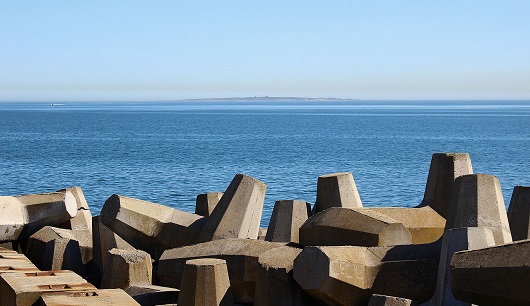Afrikaans
About Andrew Cusack
 Writer, web designer, etc.; born in New York; educated in Argentina, Scotland, and South Africa; now based in London.
Writer, web designer, etc.; born in New York; educated in Argentina, Scotland, and South Africa; now based in London. read more
News
Blogs
Reviews & Periodicals
Arts & Design
World
France
Mitteleuropa
Knickerbockers
Argentina
The Levant
Africa
Cape of Good Hope
Netherlands
Scandinavia
Québec
India
Muscovy
Germany
Academica
Klein Gidding
Bekend nie, want nie gesoek nie
Maar gehoor, half gehoor, in die stilte
tussen twee golwe van die see.
Vinnig, nou, hier, nou, altyd –
’n Voorwaarde van volledige eenvoud
(Koste nie minder nie as alles)
En alles sal wel wees
Allerhande dinge sal wel wees
As die tonge van vlam inmekaar gevou is
In die gekroonde knoop van vuur
En die vuur en die roos is een.
Dolosse
dolos, pl. dolosse
Visitors to the seaside and frequenters of port cities will be familiar with those oddly shaped concrete forms which are dropped together to form breakwaters and prevent erosion.
It turns out that they have a name of Afrikaans origin: dolos (plural dolosse).
‘Dolos’ is believed to be a contraction of ‘dollen os’, the name for the children’s toy of knucklebones or jacks. This particular shape was invented by Aubrey Kruger and Eric Mowbray Merrifield to rebuild the revetments of East London’s artificial harbours following the great storm of 1963.
Kruger fashioned a smaller version of the shape to show his idea to Merrifield, and legend has it that Kruger’s father visited them on the quayside and asked Wat speel julle met die dolos? (‘What are you playing at with the jack?’) The name stuck.
In 2016 the South African Mint released a two-rand ‘crown’ coin depicting the dolos as a tribute to this example of South African ingenuity.
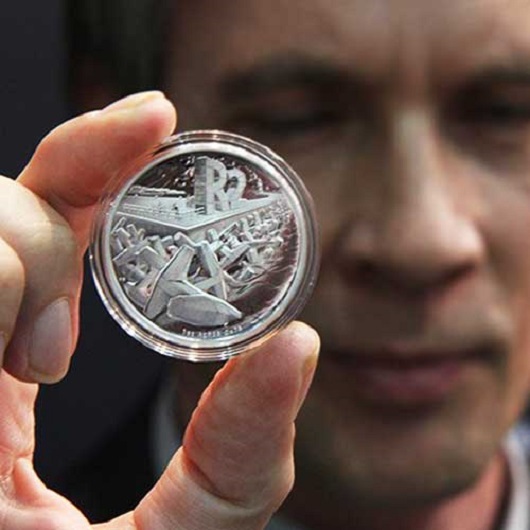
V for Victory (en Vryheid)
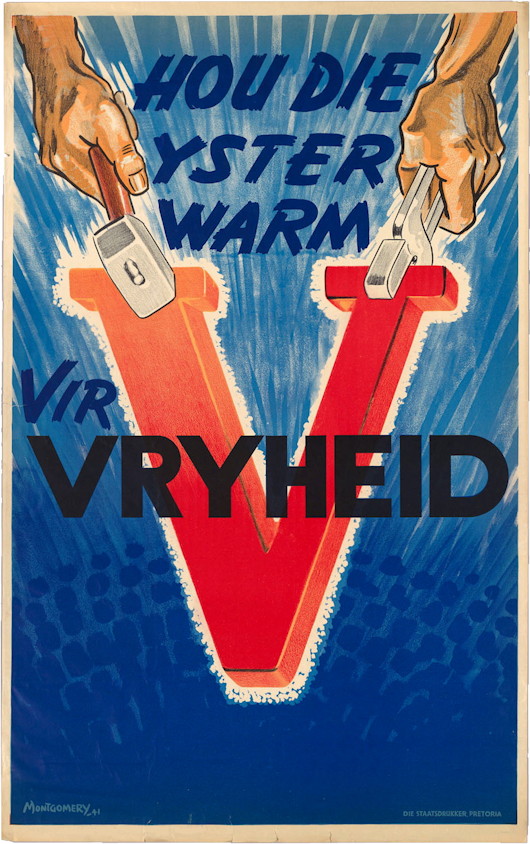
The twenty-second letter of the alphabet became a powerful symbol during the Second World War — ‘V’ for Victory, and all that. Even the Morse code for the letter — dot-dot-dot-dash — became useful, echoing as it did the famous four-note motif from Beethoven’s fifth symphony.
In South Africa, however, the two main languages were English and Afrikaans, and the Afrikaans word for victory, oorwinning, does not start with a ‘V’. Instead the letter was used to stand for vryheid, or freedom, just as in Belgium it stood for both victoire for the Walloons and vrijheid for the Flemings.
When the Second World War started Prime Minister Hertzog announced a policy of neutrality, only to be toppled as premier by his deputy and ally Smuts who brought South Africa into the war a few days later than Canada, Australia, and New Zealand.
This wartime propaganda poster, produced by the Staatsdrukker in Pretoria, urges South Africans to ‘keep the iron hot for freedom’. The country’s industrial production made a valuable contribution to the war effort in addition to the volunteer manpower of the Union Defence Force and, perhaps most importantly, the gold that came from the Witwatersrand mines.
Arms of the Oudtshoorn Oratory
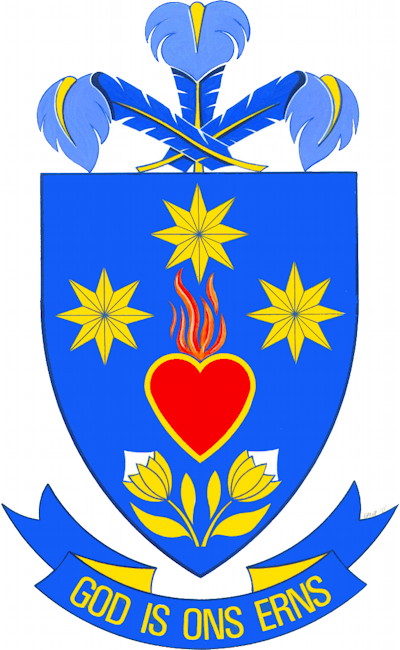
An explanation of the arms of the Afrikaans-speaking Oratory of St Philip Neri in Oudtshoorn, South Africa (edited from their own information).
Moedertaalsprekers in Suid-Afrika
Vanuit die blog van die “vryskut visuelejoernalis” Charles Apple, ons kry hierdie grafiek van sprekers van die twaalf offisiele tale van Suid-Afrika. Dit is die werk van die grafiese kunstenaar Rudi Louw van Naspers. Dié grafiek het in Die Burger verskyn. (O, Die Burger! Ek mis jou!). Afrikaans is nie eerste in nommers nie — Zoeloe is bo-op, Xhosa is volgende — maar die taal is eerste in ons harte. (Awww…) (more…)
Afrikaans Rachmaninoff Vespers a Surprise Hit
In an attempt to make great music more accessible to South African audiences, Rachmaninoff’s Vespers have been translated into Afrikaans and have proved a surprise hit. The translation of texts from the Russian Orthodox all-night vigil service was commissioned by the Vriende van Afrikaans society at the suggestion of Leon Starker, director of the Pro Cantu Youth Choir and the Cape Chamber Choir, and the translation was done by the Durbanville musicologist and polyglot Hélène Dippenaar.
The work, composed in 1915, was performed across the country during the past year, including at the Voortrekkermonument in Pretoria. A final concert at St. George’s Cathedral in Cape Town was added in response to the high demand from the music-loving public.
A compact disc of the Rachmaninoff Vespers in Afrikaans has also been released by Pro Cantu, which rehearses at Hoërskool D.F. Malan in Bellville and draws its members from across the Cape Peninsula.
Zuma in Orania
President is Welcomed at Afrikaners-Only Enclave in Northern Cape
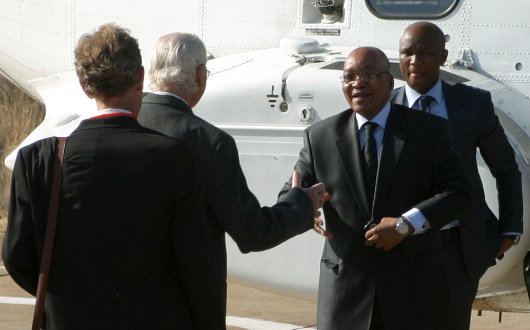
President Zuma yesterday paid a ‘goodwill visit’ to the whites-only Afrikaner enclave of Orania in the Northern Cape. The trip was prompted when Pres. Zuma received word that the town’s founded Prof. Carel Boshoff IV, was in poor health. Orania was founded in 1990, some months after whites voted to dismantle apartheid, as a place where Afrikaner self-reliance could be practiced and cultural heritage preserved. The town has pioneered various agricultural and ecological projects, and in 2004 started its own local currency, the Ora, which is equal to ten rand. (more…)
Titles in Afrikaans
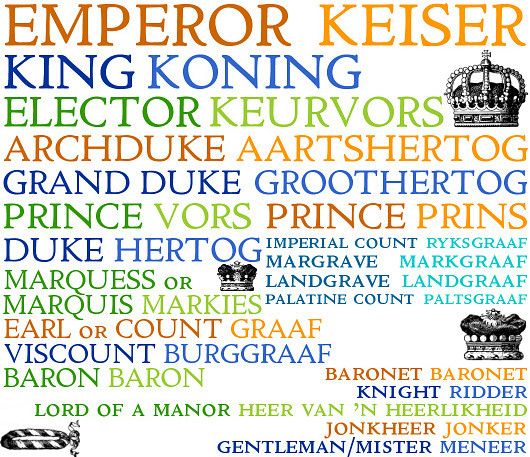
ROYAL, NOBLE, AND common titles in Afrikaans are, like most of the language, descended from Dutch antecedents which, in turn, come from German. The Cape knew not the Kingdom of the Netherlands, which was established after the Dutch relinquished the colony, but was founded as an outlet of the Dutch East India Company (or V.O.C., to give its Dutch acronym). After a brief period of British occupation, Dutch dominion over the Cape returned during the Batavian Republic before finally being seized by the British in 1806 and erected as a British colony in 1814. When the Union of South Africa was created in 1910, the country had its first king, George V, though the sovereign was generally only referred to as ‘King of South Africa’ from 1927 onwards.
The country has had no emperors, though some like to attribute that title to Shaka, the greatest King of the Zulus. Typically, however, he is known as king (as in King Shaka International Airport, Durban’s brand new landing-place). South Africa’s royalty have tended to be either native (like Prince Nelson Rolihlahla Mandela) or German (like Prince Hubertus of Prussia, d. 1950, and a few Blüchers, etc.). (more…)
Mimi Coertse: “Der Hölle Rache” van Die Zauberflöte
Van al die operahuise in Afrika, die helfte is in Suid-Afrika — dink jy, daar is net vier operahuise in die vasteland. Nietemin, opera het ’n ryk en vrugbaar tradisie in die land, en die koningin van Suid-Afrikaanse opera-sangers is die sopraan Mimi Coertse. Sy was in Durban gebore in 1932 en het haar stem-opleiding in Suid-Afrika voltooi. In 1953, Coertse het die uitsaaier en komponis Dawid Engela getroud. (Engela het sy “Huwelikskantate” vir hul troue saamgestel). In Januarie 1955, Coertse het haar opera debuut gemaak in ’n kleine rol in Parsifal by die Teatro San Carlo in Napels.
Dit was 17de Maart 1956 — St. Patrick’s Day — toe Coertse die rol van die Koningin van die nag gesing in “Die Zauberflöte” met die Weense Staatsopera in Oostenryk. Sy het met die Weense Staatsopera vir meer as twintig jare gebly. Gravin Christl Schönfeld onthou:
In sy lang voortgang, Mimi Coertse het baie eerbewyse opgestapel. In 1961, die Medalje van Eer van Die Suid-Afrikaanse Akademie vir Wetenskap en Kuns; in 1966, die prestige titel van “Kammersängerin” vanaf die regering van Oostenryk; in 1985, die Suid-Afrikaanse Dekorasie vir Voortreflike Diens; en in 1996, die “Oesterreichische Ehrenkreuz für Wissenschaft und Kunst” (Oostenrykse Erekruis vir Wetenskap en Kuns) — die hoogste kunsdekorasie van Oostenryk.
Waar is sy nou? Sedert 1998, Mimi Coertse bestuur die “Black Tie Ensemble” — ’n projek om die verandering tussen opleiding en professionele uitvoering te versag. ’n Halfeeu van diens in die kunste voortsit!
’n Indiese woning in die Moederstad
Kaapstad het ’n bietjie van die Himalajas
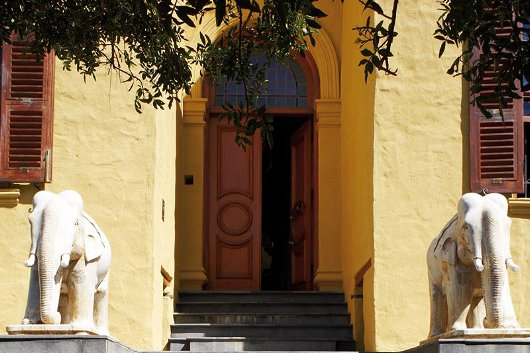
Twee versamelaars van suid-Asiatiese kuns het ’n subkontinentale woning in ’n Kaapstadse meenthuis geskep. Die huis was die onderwerp van ’n artikel deur Johan van Zyl in ’n onlangse uitgawe van Visi-tydskrif met hierdie foto’s van Mark Williams. Die algehele effek is ’n bietjie “over the top” vir my, maar die verleiding van die Oriënt sal nooit ophou. (Bo: ’n Paar van marmer-olifante uit Udaipur wagte by die hoofingang).
“In ’n nou keisteenstraat aan die rand van die Kaapse middestad staan ’n huis met ‘n geskiedenis” Mnr van Zyl skryf. “Toe dit in 1830 vir Britse soldate gebou is, het die branders nog digby die voordeur geklots, en nie lank daarna nie het Lady Anne Barnard hier sit en peusel aan ’n geilsoet vy wat ’n slaaf vir haar gepluk het, stellig van dieselfde boom wat nou in die huis se (nuwe) trippelvolume-glashart staan, ’n knewel met ’n vol lewe agter die blad.”
“’n Dekade of twee gelede het die reeds luisterryke geskiedenis van die huis ’n eksotiese dimensie bygekry toe twee toegewyde versamelaars — selferkende stadsjapies wat destyds in die modebedryf werksaam was — hier kom nesskop met hulle groeiende versameling Indiese oudhede.” (more…)
An Old Dutch Holdout
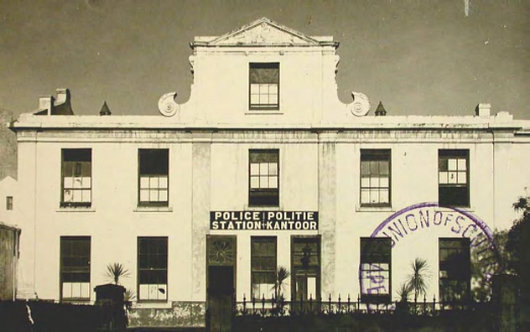
The sign on the façade of No. 7 Wale Street, Cape Town in this 1891 photo informs us of its status as a police station in the two official languages of the day, English and Dutch, not Afrikaans. ‘Politie’ is the Dutch word for Police, while the Afrikaans is ‘Polisie’. Afrikaans only became an official language of South Africa in 1925, but was so alongside Dutch and English until 1961, when Dutch was finally dropped.
This beautiful old Dutch townhouse, with its typical dak-kamer atop, didn’t survive as late as 1961. The Provinsiale-gebou, home to the Western Cape Provincial Parliament, was built on the site in the 1930s. Those who viewed the 2009 AMC/ITV reinterpretation of “The Prisoner” might remember an outdoors nighttime city scene after the main character leaves a diner, with the street sign proclaiming “Madison Ave.” and plenty of yellow New York taxicabs streaming past. The large arches in the background are the front of the Provinsiale-gebou.
A Selection of South African TV Ads
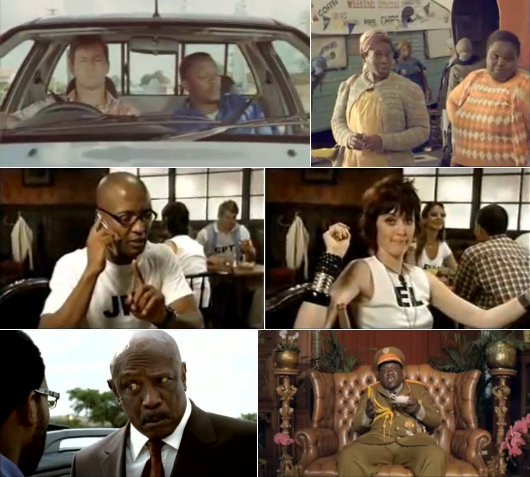
You can probably deduce a great deal about a country from its television advertisements: its sense of humour, its values perhaps, maybe even its sense of itself. Below are a cross-section of South African television ads, all of them leaning towards the humourous end of the marketing spectrum. I’ll let the reader come to his own conclusions. (more…)
Simon Kuper: Coloured Identity is an “Artificial, Ugly Leftover from Apartheid”
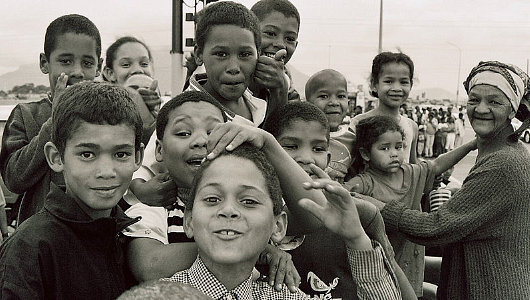
Honestly, a man like Simon Kuper should know better. The sports columnist for the Financial Times was born in Uganda, raised in the Netherlands, but both his parents are South African. In a recent article (“Apartheid casts its long dark shadow on the game”, Financial Times, 4 December 2009), Kuper discusses the racial divisions in South Africa and how they are reflected in terms of sport: White South Africans tend to gravitate towards rugby and cricket, whereas their Black compatriots overwhelmingly prefer soccer.
There exists in South Africa, however, a very large community known as the Coloureds, who are of mixed ethnic descent. Mr. Kuper, in his article, implies that they exist merely thanks to “the racial classifications of apartheid”, as if there were no Coloured people before 1948. Furthermore, he explicitly calls the difference between Coloured and Black South Africans “artificial” and an “ugly leftover from apartheid”. This is simple ignorance. He also refuses to use the word Coloured without quotation-marks, though one suspects he does not refer to Basques as “Basques”, Scots as “Scots”, Maoris as “Maoris” or so on and so forth.
The Coloureds (or kleurlinge or bruinmense in Afrikaans) are a very distinct people who form the majority of the population in the Western Cape and Northern Cape provinces. They are over four million in number and, while their distinct identity only came about after the intermarriage (and interbreeding) between the Dutch and natives after 1652, they include the genetic descendants of the old Khoisan tribes, the first people of the Cape. The Coloureds have been hugely influential in the history of the Afrikaans language, which is spoken by nine out of ten Coloured people. Just as the majority of Coloureds speak Afrikaans, the majority of Afrikaans-speakers are Coloured, not Afrikaner.
In short, Coloured people are real. They exist, and are a distinct, historical, vibrant, active culture. It is true that Coloureds are sometimes lobbed together with Zulus, Xhosa, Tswana, and others as “Black” but if one is forced to pigeon-hole them in Black-and-White terms it would be much more accurate to say either that they are both or that they are neither. Indeed, Coloureds, like Indian and White South Africans, have often faced discrimination at the hands of the ruling party, which is multi-ethnic in composition but dominated by Xhosas & Zulus in practice. The differences between Blacks and Coloureds are no more “artificial” than those between English and Irish. Mr. Kuper may want to ignore those differences (ergo, erase Coloured identity) but I say vive la différence.
Die Nuwe Kanselier
Johann Rupert is die 14de seremoniële hoof van die Universiteit van Stellenbosch

Mnr Johann Rupert, ’n afgesonderde sakeman en die seun van een van Suid-Afrika se bekendste entrepreneurs, is om die nuwe kanselier van Stellenbosch Universiteit. Dit is baie goeie nuus vir die universiteit en vir die taal, soos is mnr Rupert ’n vurige verdediger van Afrikaans. Waneer die Britse ontwerp- en leefstyltydskrif Wallpaper beskryf die taal soos “the ugliest language in the world”, Rupert — voorsitter van die Switserse luukse goedere conglomeraat Richemont — het alle advertensies vir sy groep se merken van die tydskrif verwyder. Die tydskrif het miljoene ponde in inkomste verloor, uit prominente Richemont maatskaapye soos Cartier (juweliers), Vacheron Constantin (horlosiemakers), Montblonc (penne), en Alfred Dunhill. Die Suid-Afrikaanse Akademie vir Wetenskap en Kuns, die AKTV, en ander kulturele organisasies het Rupert se optrede geondersteun.
Agtergrond van die oudste seun
Johann is die seun van die wyle entrepreneur en omgewingsbewaarder Anton Rupert, en Stellenbosch is sy tuisdorp. Hy het ook studeer ekonomie aan Stellenbosch Universiteit, wat verleen hom ‘n eredoktorsgraad in 2004. In sy vroeë jare in die sakewêreld, mnr Rupert het vir Lazard Frères in New York vir drie jaar gewerk, maar hy terug na Suid-Afrika in 1979 om Rand Merchant Bank te oprig. In 1988, Rupert stig die Compagnie Financière Richemont, en hy is nog steeds voorsitter. Ten spyte van sy rykdom, hy die soeklig vermy, en die Financial Times noem hom “reclusive”. Die selfde koerant bynaam hom “Rupert the Bear” vir sy korrek pessimistiese ekonomiese voorspellings.
’n Sterk kampvegter vir Afrikaans
Die Burger, die Kaap se koerant van rekord, sê: “Hoewel die pos van kanselier grootliks seremonieel is, kan ’n mens verwag dat iemand van Rupert se statuur en ywer ook hier sy rol op ’n vars en innoverende wyse sal vervul.”
“Sy openbare rekord as deeglike sakeman en uitsonderlike entrepreneur spreek immers vanself,” sê die koerant. “Rupert se uitmuntende sakeleierskap en visie het hom reeds verskeie toekennings op internasionale en nasionale vlak besorg. Hieronder tel Mees Invloedryke Leier in Suid-Afrika (drie keer), een van die internasionale leiers van die toekoms en handevol ander toekennings.”
“Die Burger het natuurlik sélf bande met Rupert. Hy is ’n vorige sakeleier van die jaar van dié koerant en en die Kaapstadse Sakekamer. Buite die sake-arena is Rupert ’n sterk kampvegter vir Afrikaans en is hy nou betrokke by sportontwikkeling.”
“Die mantel van kanselier val op hom in ’n tyd van besondere uitdagings aan tersiêre inrigtings. Maties self worstel met die uitdagings van transformasie en veral met die kwessie van Afrikaans as onderrigmedium. Daar kan verwag word dat Rupert ook by die US ’n sterk en rigtinggewende rol sal speel.”
NOTA VIR AFRIKAANS-SPREKENDES: Ek hoop dat u my arme grammatika sal verskoning. Dit is nie my moedertaal nie, maar ek hou van die taal.
Wits Scientists Unearth Afrikaans Dinosaur in the Orange Free State
Bones of “Aardonyx Celestae” on Display at the Transvaal Museum
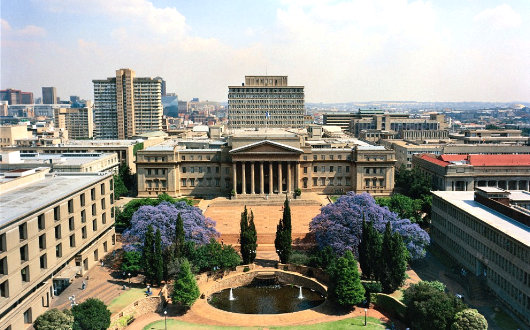
A NEW SPECIES OF dinosaur has been discovered in South Africa by a team of researchers from the University of Witwatersrand (above, colloquially known as “Wits”), and has been given an appropriately Afrikaans moniker. The new classification of Aardonyx Celestae is a combination of Afrikaans, Greek, and Latin meaning “Celeste’s Earth-claw”, after the female team member who first handled the speciment. The 23-foot long collection of fossils was found near Bethlehem in the Orange Free State, and, after the announcement before the gentlemen of the press, the bones are now displayed at the Transvaal Museum in the South African capital of Pretoria.
The specimen discovered is about 195 million years old, dating from the Early Jurassic Period (presuming one actually doubts Ussher’s chronology). Limb proportions lead the experts to believe that Aardonyx was a biped, although its forearm bones interlock (like those of quadrupeds) suggesting that it could occasionally walk on all-fours.
Unlike most Afrikaners, though, Aardonyx was a vegetarian, taking in huge mouthfuls of vegetation through its broad jaw.
Braai at the Dutch House
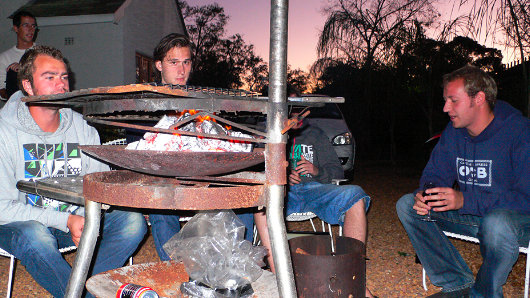
THE CUSACKIAN DICTIONARY OF the English Language defines the word braai thusly: “braai; S.Afr. [Afrikaans, lit. ‘to grill’.] n. and v. trans. and intr.; An out-door meal at which meat is grilled by the heat emanating from the embers of burnt wood.” The uncultured observer, when informed of a braai, often incorrectly equates it with a barbecue. The chief difference between a barbecue and a braai is that a barbecue tends to use either propane gas or ready-made charcoals, while the laboursome but worthwhile burning of wood is necessary to a braai. (more…)
Die Koninkryk van die Swart Pelikaan
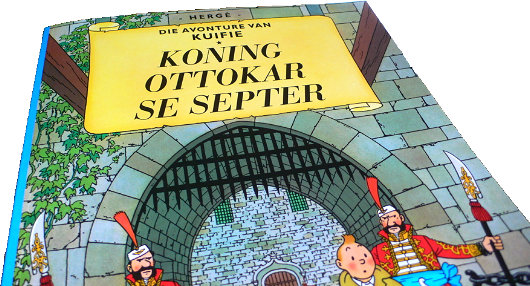
SYLDAVIA IS MY favourite country in the world. The buildings are old, the peasants are happy, and the king is ruling from his throne. Adding to my collection of Tintin books, the preponderance of which remain in New York, I know have three Afrikaans editions of Hergé’s works: Die Blou Lotus, Die Geheim van ‘De Eenhoorn’, and — my preferred among all the Tintin books — Koning Ottokar se Septer. Aside from Afrikaans, the rest of my copies are all either in French or English. I have a copy of the reprinted Tintin au Pays des Soviets and I just recently bought a copy of Tintin in the Congo, as I figured the European Union’s attempt to ban the book might make it harder to come by in years to come. I bought a copy of Le Sceptre d’Ottokar in a gas station in Brittany, one of the six special editions with a preface by Bernard Tordeur of the Hergé Foundation released in 1999/2000. Aside from Au Pays des Soviets & Le Sceptre, the only other French editions I have are L’Île Noire and Le Lotus bleu. (more…)
Some Afrikaners
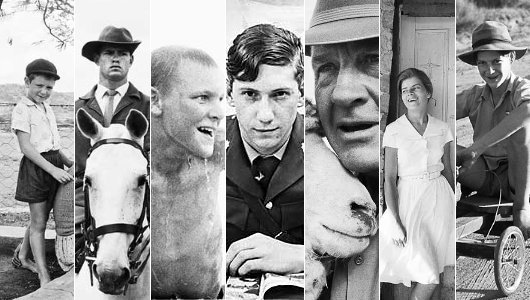
“In my father’s shop,” writes the photographer David Goldblatt, “serving Afrikaners, I found, almost in spite of myself, that I liked many of them and, to my surprise, that I was beginning to enjoy the language. There was a warm straightforwardness and an earthiness in many of these people that was richly and idiomatically expressed in their speech. And, although I have never advanced beyond being able to speak a sort of kombuistaal, I delighted in our conversations. Yet, withal, I was very aware that not only were most of these people Nationalists, strong supporters of the Party and its policies, but that many were racist in their very blood. Although anti-Semitism was now seldom overt, they made no secret of their attitude to blacks, who at best were children in need of guidance and correction, at worst sub-human. I was much troubled by the contradictory feelings of liking, revulsion, and fear that these Afrikaner encounters aroused in me and felt the need somehow to come closer to these lives and to probe their meaning for me. I wanted to do this with the camera.
“I had begun to use the camera long before this in a socially conscious way. And so I began to explore working-class Afrikaner life in our district. I drove out to the kleinhoewes around the town. I would stop and ask people if I might do some portraits of them or spend time with them while they went about whatever they were doing. In this way I became intimate with some of the qualities of everyday Afrikaner life in these places, and with some of its deeply embedded contradictions.
“An old man sits for me. A black child comes and stands next to him, looking at me with curiosity. The man turns and says to the child, ‘Ja, wat maak jy hier, jou swart vuilgoed?‘ (Yes, what are you doing here, you black rubbish?), the insult meant and yet said with affection. How is this possible? I don’t know. But the contradiction was eloquent of much that I found in the relationship between rural and working-class Afrikaners and blacks: an often comfortable, affectionate, even physical intimacy seldom seen in the ‘liberal’ circles in which I moved, and yet, simultaneously, a deep contempt and fear of blacks. …
“Travelling through vast, sparsely populated parts of the country with my camera became a major part of my life at that time. I think that our landscape is an essential ingredient in any attempt at understanding not just the Afrikaner but all of us here. We have shaped the land and the land has shaped us. Often the land was unforgivingly harsh. Yet, the harsher the landscape the stronger the Afrikaners’ sense of belonging seemed to be. Many of the people whom I met in the course of those trips had a rootedness in the land of which I was very envious. Envious in the sense that I couldn’t claim 300 years of ancestry in this country. Yet, increasingly, I felt viscerally bonded to it.”
‘We’ve Lost More Than We’ll Ever Know’
In Three Corners of the Commonwealth, Popular Musicians Demonstrate Rejection of Modernity
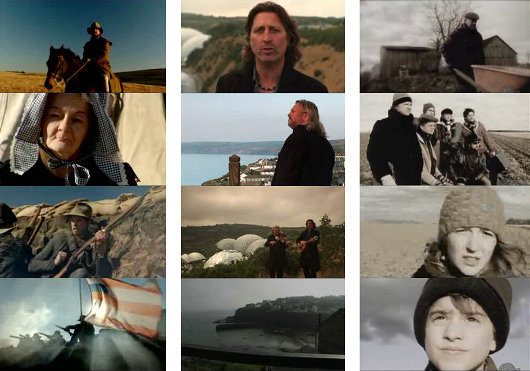
In South Africa, England, and Quebec, popular musicians have expressed regret over the rejection of their traditional cultures by the destructive onward march of modernity. The hugely popular song ‘De La Rey’, sung in Afrikaans by Bok van Blerk I have already explored in greater depth in an article for Norumbega, but ‘Roots’ by England’s Show of Hands and ‘Dégénération’ by Québécois group Mes Aïeux are worthy of notice.
‘Roots’, as one would expect from the title, decries the severing of the English people from their lyrical musical tradition and lifestyle, being replaced by “Indian, Asian, Afro-Celt”, while the song’s refrain evokes images of a people adrift: “Haul away boys let them go/ Out in the wind and the rain and snow/ We’ve lost more than we’ll ever know/ On the rocky shores of England”. In one verse, the song taps into a particular pet peeve of mine, the complete invasion of pubs by the dreaded television screen:
Is three folk singers in a pub near Wells
Well I’ve got a vision of urban sprawl
Pubs where no one ever sings at all
And everyone is staring at a TV screen
Overpaid soccer stars, prancing teens
Australian soap, American rap
Estuary English, Baseball cap
There is no greater killer of good conversation than the massive influx of television screens into the pubs. Just the other evening I was down in our regular in Bronxville and from my vantage point alone I could see three television screens. The bright technicolor projection of baseball, soccer, football, and rugby into an otherwise dark space is too great a distraction for the eye. Bad enough sitting in a booth, it is even worse having dinner at the bar when you do not at least have the advantage of sitting opposite your drinking companion. How much more of a good time it would be without those dazzling displays, and without the obnoxiously loud music, either piped in from the jukebox or else some third-rate band singing third-rate cover songs of third-rate rock groups. Bleccch! It is those moments when one yearns to be ensconced by the fire in the Russell on the Scores in St Andrews, either accompanied solely by a book and a solid pint, or engaged in the usual joviality with the after-Rosary crowd.
The Québécois song, meanwhile, laments the decline of the family from large in size and from tied to the earth to solitary and confined in the city. The name of the band — Mes Aïeux — means “My Ancestors” and ‘Dégénération’ is a play on words, meaning ‘degeneration’ but also soundling like ‘des generations’ — ‘of the generations’. The song opens:
Ton arrière-grand-père, il a labouré la terre
Et pi ton grand-père a rentabilisé la terre
pis ton père, il l’a vendu pour devenir fonctionnaire
Et pi toé mon p’tit gars, tu sais pu c’que tu vas faire
Dans ton p’tit trois et d’mi ben trop cher, frète en hiver
Il te vient des envies de dev’nir propriétaire
Et tu rêves la nuit d’avoir ton petit lopin d’terre
Your great-great grandfather cleared the earth
Your great-grandfather laboured on the earth
Your grandfather turned a profit from the earth
Then your father sold the earth to become a bureaucrat
Now you, my little man, you don’t know what to do
In your little 3 room apartment – too expensive and cold in the winter
You want something to call your own
And you dream at night of having your own little piece of earth.
The next verse goes on about the maternal line of the family: the great-great grandmother “had fourteen kids”, the next generation “had about as many”, the next “had three, that was enough for her” but “Your mom didn’t want any, you were an accident”.
Quand tu fais des conn’ries, tu t’en sauves en avortant
Mais y’a des matins, tu te réveilles en pleurant
Quand tu rêves la nuit d’une grande table entourées d’enfants
Now you, my little lady, change partners all the time
When you make a mistake you escape by aborting
But there are mornings you awake crying
When you dream in the night of a large table surrounded by little ones.
The song is one of the most popular downloads on iTunes Canada, and the band’s most recent album has gone double-platinum.
Music videos of ‘De La Rey’, ‘Roots’, and ‘Dégénération’ after the jump.
Sources Fides et Ardor: Sign of Hope – Mes Aïeux | Fides et Ardor: The People Speak (or sing…)
Previously: Breaking the Mold in Quebec | The Men Who Saved Quebec | Hitchcock in Quebec
Search
Instagram: @andcusack
Click here for my Instagram photos.Most Recent Posts
- Sag Harbor Cinema March 26, 2025
- Teutonic Takeover March 10, 2025
- Katalin Bánffy-Jelen, R.I.P. March 3, 2025
- Substack Cusackiensis March 3, 2025
- In the Courts of the Lord February 13, 2025
Most Recent Comments
Book Wishlist
Monthly Archives
Categories

